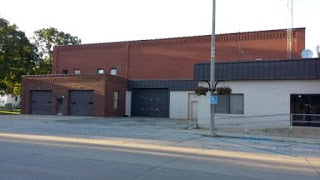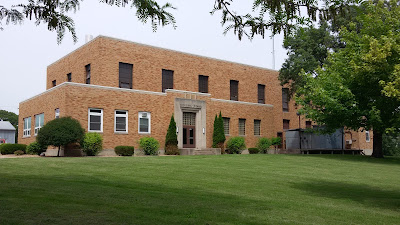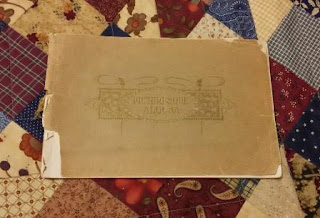Book Published
In 1900, the Algona Commercial Exchange (which I believe is similar to today's Chamber of Commerce) published a 64-page booklet entitled "Picturesque Algona." The book was compiled as a fundraising tool with copies selling for 25 cents each. Milton Starr, Harvey Ingham and J. W. Hinchon made up the Executive Committee. The Finance Committee consisted of Geo. C. Call, T. F. Cooke, C. C. Samson, Wm. K. Ferguson, S. E. McMahon and R. B. Warren. The book was filled with photographs of homes, businesses, churches and sites located in and near Algona.
The photographs of the residences and other buildings were taken by A. L. Peterson and J. F. Nicoulin, local professional photographers and studio owners. Several views of the river were contributed by Harvey Ingham and other river and wooded scenes came from Col. Thomas F. Cooke, A. L. Peterson and Will Brunson.
The photographs of the residences and other buildings were taken by A. L. Peterson and J. F. Nicoulin, local professional photographers and studio owners. Several views of the river were contributed by Harvey Ingham and other river and wooded scenes came from Col. Thomas F. Cooke, A. L. Peterson and Will Brunson.
The publication contains a quote from Prof. Walter A. Wyckoff’s book, “The Workers” which reads as follows:
"But there were native born Americans in plenty, and chiefly of New England antecedents, as I found by my chance acquaintance with farmers by the way, and from observations of such a charming town as Algona, in Northern Iowa, where I spent several days."
In 1891, Wyckoff had set off on foot with just a dollar in his pocket to work his way across the United States to experience the life of an unskilled worker. He had stopped in Algona as part of that adventure and was impressed enough to mention it in his book. Obviously his quote sufficiently moved the committee to have them include it.
By this time, Algona had been in existence for 46 years. Numerous improvements had come to the city, including many fine homes and businesses. The City certainly had a right to feel proud of the progress that had occurred in such a short period of time.
A close study of the photos reveals a city in transition. Some businesses are pictured with wooden walkways and yet others have concrete sidewalks. The streets are unpaved and are filled with horses and buggies. City Hall is shown with
 |
| Fire company in front of City Hall 1900 |
By
the late 1890s, the city badly needed a system of street lighting. In 1898, O. B. Durdall approached the city
council offering to light Algona’s streets with electricity. Mr. Durdall had investigated the costs of
such an endeavor while on a trip to Chicago.
He offered to put in forty arc lights of 1,200 candle power each to be
located on streets as directed by the council.
He proposed the city pay $4.50 a month per light for a total of $2,160 a
year. He wanted a franchise for twenty
years but offered the city the right to purchase the plant at any time during
the first five years at its actual cost or thereafter at its fair market value.
Not
everyone was in favor of a privately owned utility. Shortly after Durdall’s proposal was
presented, a group of local businessmen subscribed stock to furnish money to
the city to put in an electric light company in connection with the city water
works. The city council weighed all of
the options and finally decided on municipal ownership. They elected to purchase two 100-horse power
boilers, a Sioux City Corliss engine of 150 horse power and a 1500 light
Westinghouse alternating dynamo for the plant.
Electricity Arrives
The building was complete and ready for installation of boilers and engines by December. Unfortunately, a series of mishaps and setbacks tried the community’s patience as they labored to institute electrical service. It took three more months for
the engine to arrive.
It was soon installed and the electric current was to be turned on for
the first time on April 26, 1899. On the
first try, only the street lights would be illuminated. Incandescent lamps could not yet be used as
the switch board which was to operate that current had been destroyed in a fire
in the factory where it was made. When
the steam was turned on the new engine the first time, the throttle valve blew
off immediately and a new one had to be ordered. It took a few more weeks to fine tune all of
the details, but by late May of 1899, the plant was finally up and running.
At first the plant would shut down each night at 10 p.m. A signal would be sent to customers just before closing. When the lights dimmed three times, it was time to light their lamps. By September, the city council voted to begin
all night electric service which
was touted as a great convenience to the
hotels as well as private homes. Algona
had entered a new age just in time for the turn of a new century.
 |
| The site in 2015 |
It is the striving for improvements such as this that made Algona a very progressive community. It is that progress that “Picturesque Algona” documents.
Disappointingly,
other than the name of the owner or business, there are no descriptions of any
kind about the buildings described in the booklet. No addresses were given to aid later
generations in locating these beauties.
It is fortunate that the 1954 centennial committee took it upon
themselves to reissue this book as part of their souvenir materials. In the
updated version they included addresses and the names of the then current
owners. We owe them a sincere thank you
for their foresight and hard work.
In the future I plan to tell the stories of some of the homes and businesses featured in "Picturesque Algona." If you enjoy visiting the past, please continue to stop by my blog -- or better yet, subscribe so you are sure you don't miss a single post. You never know what topic might be next!
 |
| Algona power plant on North Hall Street in 2015 |
In the future I plan to tell the stories of some of the homes and businesses featured in "Picturesque Algona." If you enjoy visiting the past, please continue to stop by my blog -- or better yet, subscribe so you are sure you don't miss a single post. You never know what topic might be next!
Until next time,
KC History Buff
Don't miss a single post - Subscribe now!
If you enjoyed this post, please don’t
forget to “like” and SHARE.
Reminder:
The posts on Kossuth County History Buff are copyrighted © 2015 by Jean
Kramer. Please use the FB “share”
feature instead of cutting/pasting.







